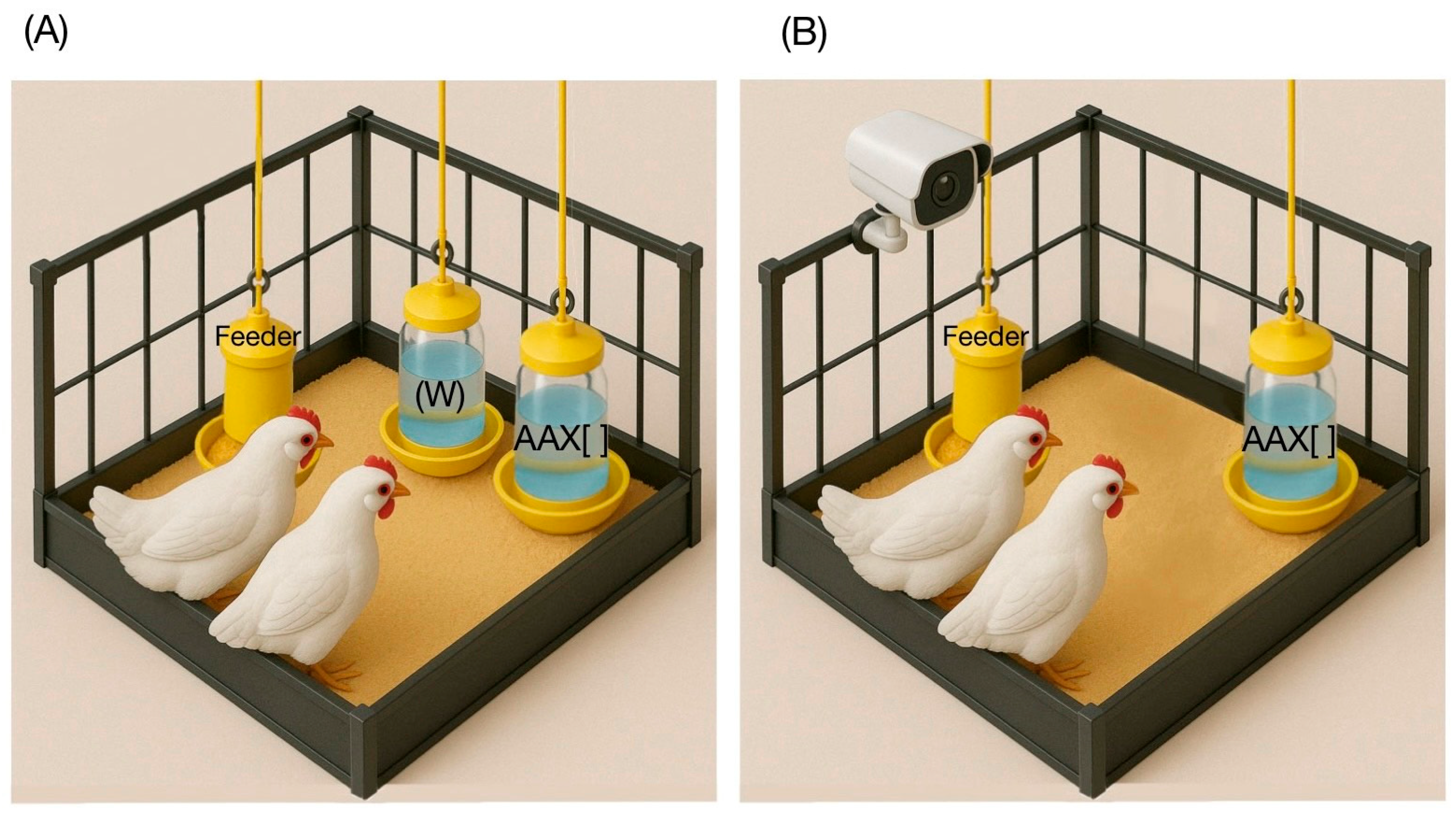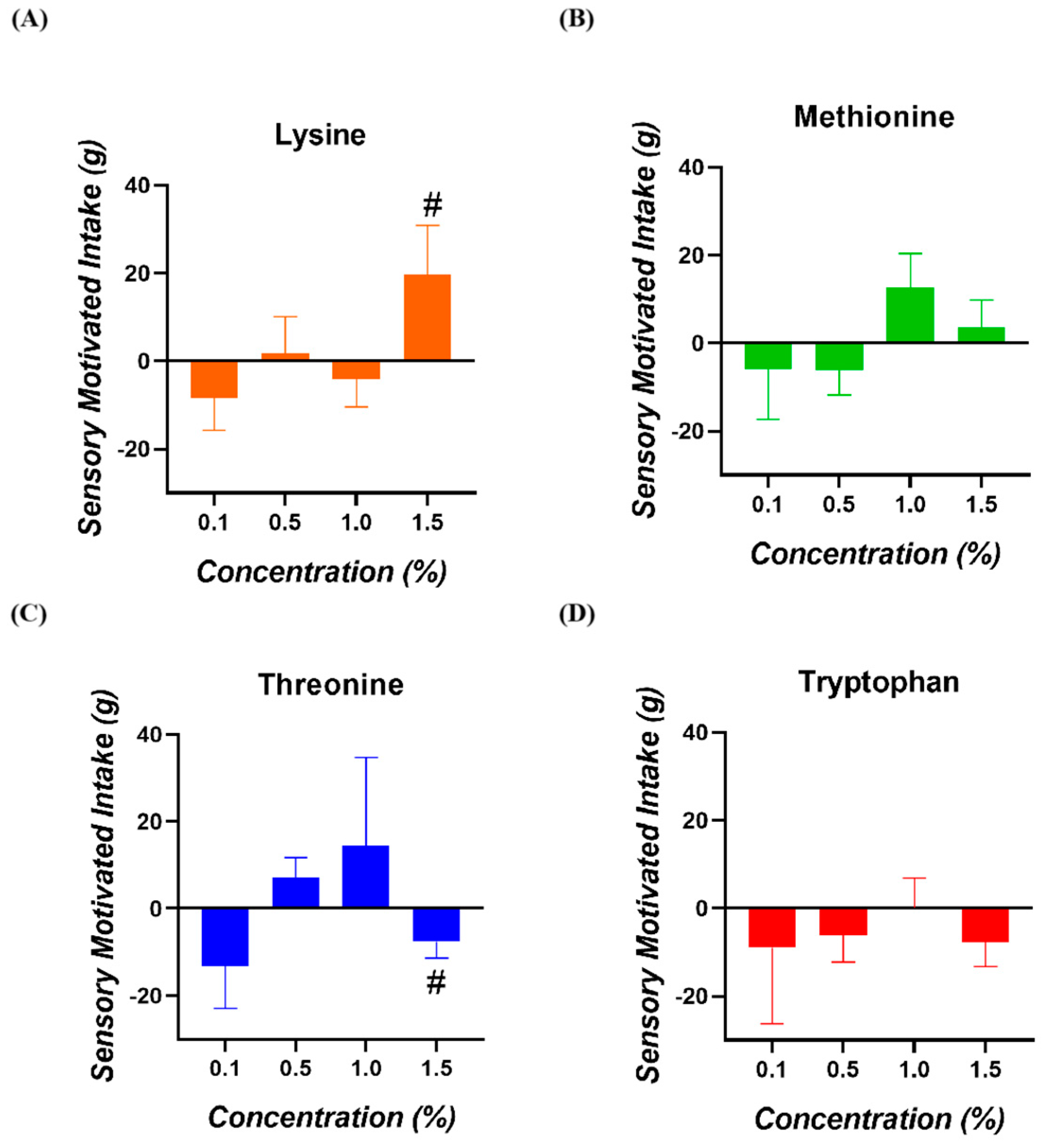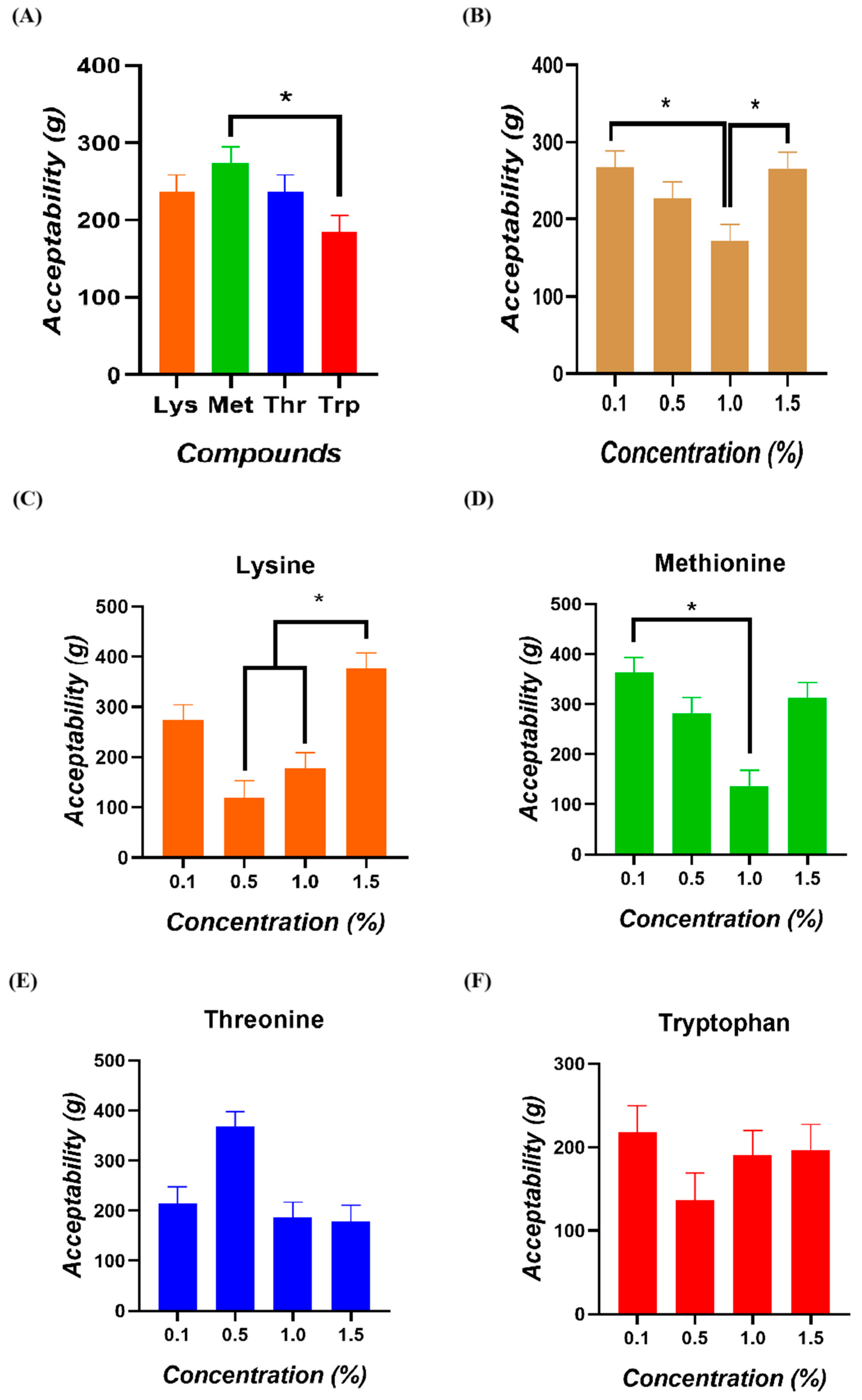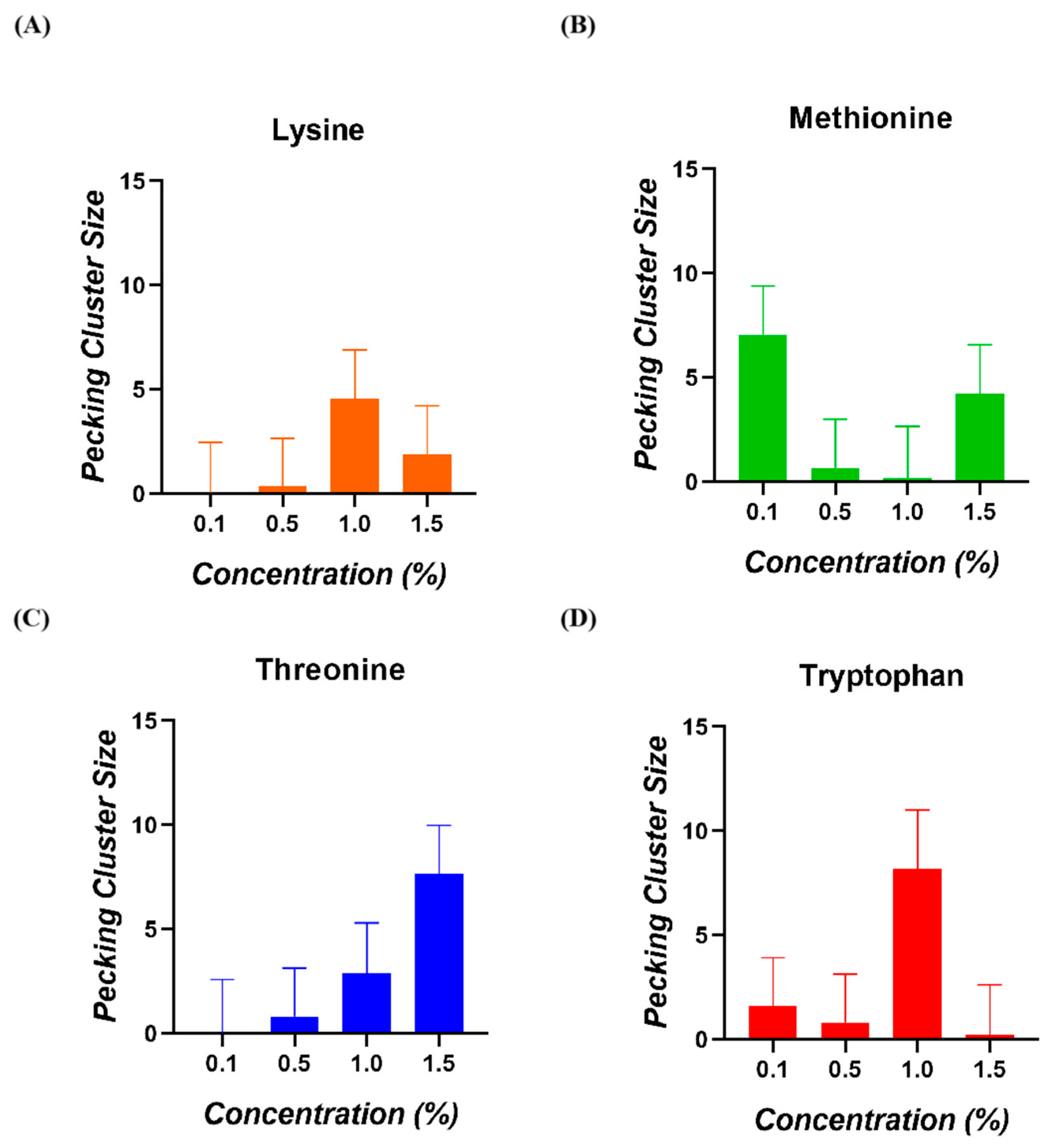Taste Preferences in Broilers: Behavioral Evaluation for Varying Concentrations of Four Essential Amino Acids
Simple Summary
Abstract
1. Introduction
2. Materials and Methods
2.1. Animals, Housing, and Diets
2.2. Experimental Design
2.2.1. Preference Thresholds
2.2.2. Sensory-Motivated Intake
2.2.3. Acceptability
2.2.4. Pecking Cluster Size
2.3. Statistical Analysis
3. Results
3.1. Two-Choice Preference Tests
3.2. Sensory-Motivated Intake
3.3. Acceptability
3.4. Pecking Cluster Size
4. Discussion
5. Conclusions
Supplementary Materials
Author Contributions
Funding
Institutional Review Board Statement
Informed Consent Statement
Data Availability Statement
Conflicts of Interest
References
- Yoshida, Y.; Kawabata, F.; Kawabata, Y.; Nishimura, S.; Tabata, S. Short-term perception of and conditioned taste aversion to umami taste, and oral expression patterns of umami taste receptors in chickens. Physiol. Behav. 2018, 191, 29–36. [Google Scholar] [CrossRef]
- Cheled-Shoval, S.; Reicher, N.; Niv, M.; Uni, Z. Detecting Thresholds for Bitter, Umami, and Sweet Tastants in Broiler Chicken using a 2-choice Test Method. Poult. Sci. 2017, 96, 2206–2218. [Google Scholar] [CrossRef] [PubMed]
- Yoshida, Y.; Kawabata, F.; Tabata, S.; Aggrey, S.; Rekaya, R.; Liu, H. Evolvement of taste sensitivity and taste buds in chickens during selective breeding. Poult. Sci. 2021, 100, 101113. [Google Scholar] [CrossRef] [PubMed]
- Roura, E.; Baldwin, M.W.; Klasing, K.C. The avian taste system: Potential implications in poultry nutrition. Anim. Feed. Sci. Technol. 2013, 180, 1–9. [Google Scholar] [CrossRef]
- Dong, B. Molecular Characterization and Expression of Umami Receptors T1R1/T1R3 in Broiler Chickens. Master´s Thesis, University of Manitoba, Department of Animal Science, Winnipeg, MB, Canada, 2016; 99p. [Google Scholar]
- Yoshida, Y.; Kawabata, Y.; Kawabata, F.; Nishimura, S.; Tabata, S. Expression of multiple umami taste receptors in oral and gastrointestinal tissues, and umami taste synergism in chickens. Biochem. Biophys. Res. Commun. 2015, 466, 346–349. [Google Scholar] [CrossRef] [PubMed]
- Cordero, P.; Herrera-Alcaíno, S.; Philp, V.; Muñoz, G.; Luna, D.; Guzmán-Pino, S.A. Taste Preferences in Broilers: Effect of Age, Delivery Matrix, and Number of Chickens per Pen on Selection and Consumption Behaviour. Animals 2024, 14, 1507. [Google Scholar] [CrossRef]
- Friedman, M.I.; Stricker, E.M. The physiological psychology of hunger: A physiological perspective. Psychol. Rev. 1976, 83, 409–431. [Google Scholar] [CrossRef]
- Forbes, J. Palatability: Principles, methodology and practice for farm animals. CAB Rev: Perspect. Agric. Vet. Sci. Nutr. Nat. Resour. 2010, 5, 1–15. [Google Scholar] [CrossRef]
- Dwyer, D.M. Microstructural analysis of conditioned and unconditioned responses to maltodextrin. Learn. Behav. 2008, 36, 149–158. [Google Scholar] [CrossRef]
- Shynkaruk, T.; Classen, H.; Crowe, T.; Schwean-Lardner, K. The impact of dark exposure on broiler feeding behaviour and weight of gastrointestinal tract segment contents. Poult. Sci. 2019, 98, 2448–2458. [Google Scholar] [CrossRef]
- Aviagen. Ross 308 Broiler: Management Pocket Guide. 2022. Available online: https://aviagen.com/assets/Tech_Center/BB_Foreign_Language_Docs/Spanish_TechDocs/Ross-BroilerHandbook2018-ES.pdf (accessed on 27 February 2023).
- Aviagen. Ross 308 Broiler: Nutrition Specifications. 2022. Available online: https://aviagen.com/assets/Tech_Center/Ross_Broiler/Ross-BroilerNutritionSpecifications2022-EN.pdf (accessed on 11 January 2023).
- Cho, S.; Kim, J.; Roura, E. A new double choice model developed in laying hens reveals high performance for L-alanine. In Proceedings of the Proceedings, Australian Poultry Science Symposium, Sydney, Australia, 14–17 February 2016; p. 95. [Google Scholar]
- Iqbal, A.; Navarro, M.; Roura, E. Effectiveness of a double choice test to assess dietary taste preferences in broiler chickens. In Proceedings of the 28th Annual Australian Poultry Science Symposium, Sydney, Australia, 13–15 February 2017; The Poultry Research Foundation—The World’s Poultry Science Association: Sydney, Australia, 2017; p. 243. [Google Scholar]
- Juárez-Hernández, E.; BarberO-Becerra, V.; López-Ramírez, A.; González-Rodríguez, L.; Ramos-Ostos, M.; Méndez-Sánchez, N.; Uribe-Esquivel, M.; Chávez-Tapia, N. Valores de normalidad de umbrales de percepción y reconocimiento de sabores básicos en población mexicana sana. Med. Sur. 2015, 22, 4–10. [Google Scholar]
- Daly, K.; Al-Rammahi, M.; Moran, A.; Marcello, M.; Ninomiya, Y.; Shirazi-Beechey, S.P. Sensing of amino acids by the gut-expressed taste receptor T1R1-T1R3 stimulates CCK secretion. Am. J. Physiol. Gastrointest. Liver. Physiol. 2013, 304, 271–282. [Google Scholar] [CrossRef] [PubMed]
- Yoshida, Y.; Kawabata, F.; Nishimura, S.; Tabata, S. The umami receptor T1R1-T1R3 heterodimer is rarely formed in chickens. Sci. Rep. 2021, 11, 12318. [Google Scholar] [CrossRef] [PubMed]
- Gentle, M. Taste and its importance to the domestic chicken. Br. Poult. Sci. 1971, 12, 77–86. [Google Scholar] [CrossRef]
- Niknafs, S.; Roura, E. Nutrient sensing, taste, and feed intake in avian species. Nutr. Res. Rev. 2018, 31, 256–266. [Google Scholar] [CrossRef]
- Liu, H.X.; Rajapaksha, P.; Wang, Z.; Kramer, N.E.; Marshall, B.J. An Update on the Sense of Taste in Chickens: A Better Developed System than Previously Appreciated. Int. J. Food. Sci. Nutr. 2018, 8, 686. [Google Scholar] [CrossRef]
- Rowland, H.; Rockwell, M.; Jiang, P.; Reed, D.; Beuchamp, G. Comparative Taste Biology with Special Focus on Birds and Reptiles. In Handbook of Olfaction and Gustation, 3rd ed.; Wiley Blackwell: Hoboken, NJ, USA, 2015; pp. 957–982. [Google Scholar] [CrossRef]
- Cordero, P.; Ramírez-Toloza, G.; Dufflocq, P.; Herrera-Alcaíno, S.; Guzmán-Pino, S.A. Reduced Dietary Protein and Essential Amino Acids Impair Growth Performance and Increase Lysine Sensitivity in Broiler Chickens. Animals 2025, 15, 1027. [Google Scholar] [CrossRef]
- Wilson, A.; Downs, C. Food preferences of Knysna and purple-crested turacos fed varying concentrations of equicaloric and equimolar artificial fruit. J. Exp. Biol. 2011, 21, 613–618. [Google Scholar] [CrossRef] [PubMed]
- Dando, R. Endogenous peripheral neuromodulators of the mammalian taste bud. J. Neurophysiol. 2010, 104, 1835–1837. [Google Scholar] [CrossRef]
- Chrystal, P.V.; Greenhalgh, S.; Selle, P.H.; Liu, S.Y. Facilitating the acceptance of tangibly reduced-crude protein diets for chicken-meat production. Anim. Nutr. 2020, 6, 247–257. [Google Scholar] [CrossRef]
- Arce, M.A.; Tirado, C.; López, G.; Avila, F.J. Ibey. Response to Productive Parameters to Supplementation with Alimets in Practical Diets for Broiler Chickens in México. Novus Oct. 1993, 93.103 p. Available online: https://www.novusint.com/products/poultry-alimet/ (accessed on 12 January 2022).
- Schutte, J. Sulfur amino acid requirement of broiler chicks from fourteen to thirty-eight days of age. 1. Performance and carcass yield. Poult. Sci. 1995, 74, 480–487. [Google Scholar] [CrossRef] [PubMed]
- Intriago, J.O.; Gernat, A.G. Efecto de cuatro niveles de metionina en dietas de pollos de engorde durante la primera semana de vida. Ceiba 1999, 40, 287–290. Available online: https://revistas.zamorano.edu/index.php/CEIBA/article/view/445 (accessed on 10 March 2023).
- Wu, G. Functional amino acids in nutrition and health. Amino Acids 2013, 45, 407–411. [Google Scholar] [CrossRef] [PubMed]
- Betancourt López, L.; Cacua León, L.; Alarcón Parra, A. Effect of tryptophan supplementation in quails (Coturnix coturnix Japónesa). Rev. Med. Vet. 2005, 83–87. [Google Scholar] [CrossRef]
- Li, Q.; Ouyang, J.; Deng, C.; Zhou, H.; You, J.; Li, G. Effects of dietary tryptophan supplementation on rectal temperature, humoral immunity, and cecal microflora composition of heat-stressed broiler chickens. Vet. Sci. 2023, 10, 1247260. [Google Scholar] [CrossRef]
- Kidd, M.T. Nutritional considerations concerning threonine in broilers. World’s Poult. Sci. J. 2000, 56, 139–151. [Google Scholar] [CrossRef]
- Motl, M.A.; Fritts, C.A.; Waldroup, P.W. Influence of dietary sodium level on utilization of methionine from DL-methionine and liquid methionine-hydroxy analogue. J. Appl. Poult. Res. 2005, 14, 147–155. [Google Scholar] [CrossRef]
- Le Floc’h, N.; Seve, B. Biological roles of tryptophan and its metabolism: Potential implications for pig feeding. Livest. Sci. 2007, 112, 23–32. [Google Scholar] [CrossRef]
- Tian, D.L.; Guo, R.J.; Li, Y.M.; Chen, P.P.; Zi, B.B.; Wang, J.J.; Liu, R.F.; Min, Y.N.; Wang, Z.P.; Niu, Z.Y.; et al. Effects of lysine deficiency or excess on growth and the expression of lipid metabolism genes in slow growing broilers. Poult Sci. 2019, 98, 2927–2932. [Google Scholar] [CrossRef]
- Mejía, L.; Tillman, P.B.; Corzo, A. Evaluation of the Threonine/Lysine Ratio in Broiler Chickens Aged 35 to 49 Days. 2011. Engormix. Available online: https://www.engormix.com/avicultura/aminoacidos-aves/evaluacion-proporcion-treonina-lisina_a28895/ (accessed on 5 February 2023).
- Hussain, M.; Mahmud, A.; Hussain, J.; Qaisrani, S.N.; Mehmood, S.; Rehman, A. Subsequent effect of dietary lysine regimens fed in the starter phase on the growth performance, carcass traits and meat chemical composition of aseel Chicken in the Grower Phase. Braz. J. Poult. Sci. 2018, 20, 455–462. [Google Scholar] [CrossRef]
- Lee, C.Y.; Song, A.A.-L.; Loh, T.C.; Abdul Rahim, R. Effects of lysine and methionine in a low crude protein diet on the growth performance and gene expression of immunity genes in broilers. Poult. Sci. 2020, 99, 2916–2925. [Google Scholar] [CrossRef] [PubMed]
- Rostagno, H.S.; Albino, L.F.T.; Calderano, A.A.; Hannas, M.I.; Sakomura, N.K.; Perazzo, F.G.; Rocha, G.C.; Saraiva, A.; Teixeira de Abreu, M.L.; Genova, J.L.; et al. Brazilian Tables for Poultry and Swine: Feed Composition and Nutritional Requirements, 5th ed.; Dueñez, W.Y.S., Translator; Department of Animal Science, Federal University of Viçosa: Armidale, Australia, 2024. [Google Scholar]





Disclaimer/Publisher’s Note: The statements, opinions and data contained in all publications are solely those of the individual author(s) and contributor(s) and not of MDPI and/or the editor(s). MDPI and/or the editor(s) disclaim responsibility for any injury to people or property resulting from any ideas, methods, instructions or products referred to in the content. |
© 2025 by the authors. Licensee MDPI, Basel, Switzerland. This article is an open access article distributed under the terms and conditions of the Creative Commons Attribution (CC BY) license (https://creativecommons.org/licenses/by/4.0/).
Share and Cite
Figueroa, J.; Cordero, P.; Herrera-Alcaíno, S.; Guzmán-Pino, S.A. Taste Preferences in Broilers: Behavioral Evaluation for Varying Concentrations of Four Essential Amino Acids. Animals 2025, 15, 1574. https://doi.org/10.3390/ani15111574
Figueroa J, Cordero P, Herrera-Alcaíno S, Guzmán-Pino SA. Taste Preferences in Broilers: Behavioral Evaluation for Varying Concentrations of Four Essential Amino Acids. Animals. 2025; 15(11):1574. https://doi.org/10.3390/ani15111574
Chicago/Turabian StyleFigueroa, Jaime, Paloma Cordero, Sofía Herrera-Alcaíno, and Sergio A. Guzmán-Pino. 2025. "Taste Preferences in Broilers: Behavioral Evaluation for Varying Concentrations of Four Essential Amino Acids" Animals 15, no. 11: 1574. https://doi.org/10.3390/ani15111574
APA StyleFigueroa, J., Cordero, P., Herrera-Alcaíno, S., & Guzmán-Pino, S. A. (2025). Taste Preferences in Broilers: Behavioral Evaluation for Varying Concentrations of Four Essential Amino Acids. Animals, 15(11), 1574. https://doi.org/10.3390/ani15111574





